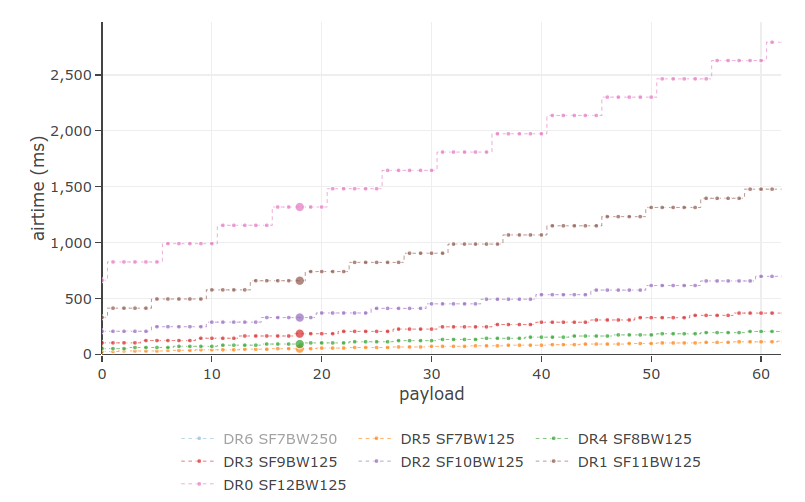Measurable Benefits
Reduced Packet Error Rate
APRS 438 geolocation beacons will encode a total of only 17 payload bytes at a time, tremendously increasing the chances of a flawless reception by an APRS 438 LoRa i‑gate. Other firmware tends to consume about six times as many LoRa payload bytes.
Important
LoRa may receive up to 20 dB under the noise floor. However, keep in mind that the packet error rate (PER) as a function of the bit error rate (BER) increases with the number of transmitted bits.
approximately, when \(BER\) is small and \(n\) is large, and where:
\((1-BER)\): the probability of receiving a bit correctly
\(n\): the number of bits in a packet; which is 8 times the number of bytes
PER Examples
When used with an explicit header (recommended), LoRa packets will have the following 36 bit overhead: a 20 bit physical header and a 16 bit payload cyclic redundancy check (CRC) at the end of the packet.

With that knowledge, take for example a bit error rate \(BER\) of one in thousand. This would result in the following packet error rates:
payload |
17 bytes |
24 bytes |
28 bytes |
45 bytes |
113 bytes |
|---|---|---|---|---|---|
overhead |
36 bits |
36 bits |
36 bits |
36 bits |
36 bits |
n |
172 bits |
228 bits |
260 bits |
396 bits |
940 bits |
BER |
0.1% |
0.1% |
0.1% |
0.1% |
0.1% |
PER |
15.8% |
20.4% |
22.9% |
32.7% |
61.0% |
By consequence, the chances of correctly receiving a 17 byte payload are more than twice as high as with a 113 byte payload:
Note
In reality, above calculations are more convoluted as LoRa employs symbols that are chip jumps or discontinuities in chirps to convey information.
Moreover, the explicit header is preceded by a preamble. The preamble consists out of a configurable length preamble, a set sync word, a start frame delimiter (SDF) and a small pause preceding the explicit header.

The variable preamble is important as it trains the receiver at receiving the signal. Hence, the symbol length of this variable preamble also has an effect on the packet error rate.
See also
Details about the LoRa packet structure can be found here.
Airtime Reduction
Keeping the payload as small as possible, has an even more important reason: to reduce the airtime required to send the LoRa frame. As calculated in equation (1), LoRa SF11 is a slow data rate mode. Reducing the airtime also saves battery power on portable devices.
Due to the LoRa symbol encoding scheme, airtime reductions occur in abrupt steps of 4 payload bytes when the spreading factor is SF11 and the bandwidth 125 kHz (CR=1, explicit header, CRC=on). This is depicted by the second stepped trace from the top in Figure 2 (adapted from airtime-calculator).

Figure 2 The top trace is for SF12BW125. The dot represents a total payload of 17 bytes as proposed for geolocation packets with compression.
payload |
5 bytes |
17 bytes |
24 bytes |
28 bytes |
45 bytes |
113 bytes |
|---|---|---|---|---|---|---|
airtime with SF12 |
0.83 s |
1.32 s |
1.48 s |
1.65 s |
2.14 s |
4.43 s |
airtime with SF11 |
0.50 s |
0.66 s |
0.82 s |
0.91 s |
1.15 s |
2.46 s |
airtime with SF10 |
0.25 s |
0.33 s |
0.37 s |
0.41 s |
0.56 s |
1.23 s |
See also
The Things Network (TTN) organisation, albeit a global LoRaWAN, is exemplary in stressing the importance of maintaining LoRa payloads small.